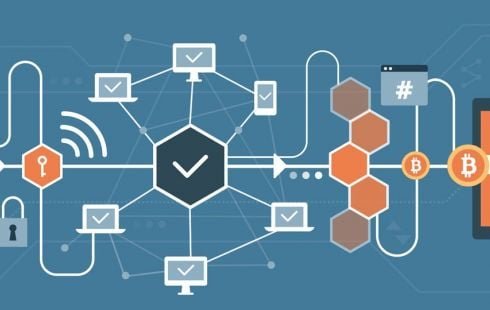A blockchain is a next-generation transactional database. The technology was created in order to facilitate digital currencies but has since evolved to have much wider applications in the realm of digital assets in general. At its core, a blockchain is a decentralized ledger system that can be used to record transactions between peers without the need for a trusted broker. By using blockchains, firms can reduce cost, time, and risk when creating new business networks.

A blockchain is a continuously growing list of records, called blocks, which are linked and secured using cryptography. Each block typically contains a hash pointer as a link to a previous block, a timestamp and transaction data. By design, blockchains are inherently resistant to modification of the data.
Bitcoin Blockchain is the first cryptocurrency that has gained importance in the financial world, mostly because it offers untampered security to all the financial transactions that are done using Bitcoin - which happens to be the first cryptocurrency ever used widely.
Bitcoin being the first of its kind experiment is still the most expensive currency over the internet and its success is followed by many other projects which somehow try to solve problems associated with Bitcoin Blockchain. For example, Etherium blockchain allows for Smart Contracts, and Steem Blockchain allows more transactions per second than that of Bitcoin Blockchain. Some projects like Monero, Blackcoin, and Peercoin are totally different currencies that also tries to overcome issues of Bitcoin Blockchain. Each currency has its own advantages and disadvantages with respect to each other which makes trading with these currencies more interesting. Blockchain technology has brought many new projects to the forefront of the cryptocurrency industry. Ethereum, for example, is now widely used worldwide by developers to create their own applications on top of its infrastructure. Steem, another blockchain platform, allows students and researchers to create academic articles and even be paid for them.
As far as financial use cases are concerned, with blockchain, we can do almost any kind of electronic cash transaction. Not only that we don't need a trusted third party in our payment transactions. All the transactions are being processed by blockchain technology and all the payments can be carried out peer to peer(p2p) without any human intervention. This will not only save the processing fee but also make the transaction faster and accurate with no chances of breach or duplication of the transaction. Blockchain technology is driving innovation in the FinTech sector. The Blockchain is a ledger for disintermediated value transfer and has been gaining mainstream adoption from providers of financial services to a diverse range of speciality applications. More and more FinTech startups are incorporating blockchain into their operations, exploring a number of use cases where blockchain technology can be applied to provide increased transparency, efficiency, and security.
Blockchain revolutionised the world of finance and is now poised to redefine how we approach everything from supply chain management to humanitarian relief efforts. Finance continues to be the biggest beneficiary of the blockchain today. But consumer brands, agtech, healthcare, media, entertainment are all likely to be transformed in the next 5-10 years due to the blockchain. The pace of change is accelerating as enterprises adopt an enterprise-wide perspective to build blockchain applications that redefine how business operations are performed. Together, both entrepreneurs and enterprises are laying the groundwork for a digital future that will ultimately impact millions of people directly or indirectly.
Definitions
Blockchain
A blockchain is a peer-to-peer network that timestamps records by hashing them into an ongoing chain of hash-based proof-of-work, forming a record that cannot be changed without redoing the proof-of-work.
Distributed Ledger System
A distributed ledger is a peer-to-peer network, which uses a defined consensus mechanism to prevent modification of an ordered series of time-stamped records.
Hash Function
A hash function is an algorithm mapping or translation of one sequence of bits into
another, generally smaller, set known as hash-result such that an electronic record yields the same hash-result every time the algorithm is executed with the same electronic record as its input making it computationally infeasible to
to derive or reconstruct the original electronic record from the hash result produced by the algorithm;
that two electronic records can produce the same hash result using the same algorithm.
Blockchain Components
Blockchain Platform
Used interchangeably with the term distributed ledger system; examples - bitcoin, ethereum, multichain, sawtooth;
Blockchain Instance
A running implementation of blockchain including the block data and block headers;
Blockchain Nodes
The systems on which a blockchain instance is installed; nodes replicate, access, write to and maintain a single series of linked blocks of transactions; nodes for a single blockchain may be spread across several geographies and organizations
Blockchain Connector
A desktop or laptop used to connect to the blockchain node using ssh
External Interface
A blockchain explorer program
Blockchain Development Ecosystem
The technological ecosystem of the entities where the design, development, upgrade, and maintenance of the blockchain takes place;
Blockchain User Ecosystem
The technological ecosystem of the end-users of the blockchain.